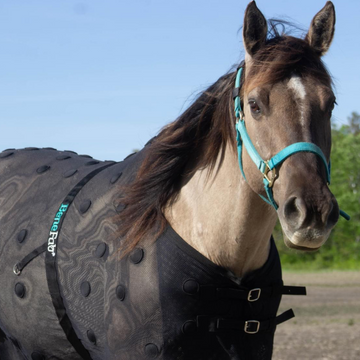 One important thing to consider is your horse's hoof health. The American Farrer Association shares the following tips on winter hoof care:
Pick out hooves everyday and examine them and the pastern area for bruises, cuts or the start of skin infections. It’s important to have any ailments treated quickly.
Since hoof growth is often slower in cold weather, cracks and other hoof wall defects might not grow out as quickly.
Your farrier might choose to leave your unshod horse a little longer to give your horse more clearance to help avoid sole bruises as they walk on frozen mud.
Shod horses might need traction such as Borium, studs or other applications. Spreading sand or cat litter on paths or at the barn entrance/exit might help both horses and humans.
Frozen ground might increase concussion on your horse’s hooves, which can lead to hoof cracks and lameness. If you don’t have access to an unfrozen riding area, it’s a good idea to limit the amount of intense work you ask of your horse.
Although unshod hooves shed snow more efficiently, shod hooves collect hardened snow more readily, which can be dangerous while walking or make walking difficult. Ask your farrier about solutions that can help your horse.
Frozen streams and ponds are obviously slippery for horses, as well as humans, but they also can be hazardous as they can break through and become immersed in frigid water. If possible, turn out horses in safe areas or fence off the hazard.
There are a few old wives' tails about keeping ice and snow balls out of horse's hooves. Everything from using Pam cooking spray, Crisco, Vaseline, Musher's Secret or wrapping part of the hoof in duct tape just to name a few. From our research, most horse owners say these suggestions worked short term. They shared that in order to get the best results you must have a warm, dry hoof.
Our suggestion is to check with your farrier on any hoof question that comes up. If you use the same farrier consistently, they know your horse. They can give you some options to ensure your horses's hooves stay healthy throughout the winter months.
As always, here at Benefab, we want to help you and your horse to feel your very best.
One important thing to consider is your horse's hoof health. The American Farrer Association shares the following tips on winter hoof care:
Pick out hooves everyday and examine them and the pastern area for bruises, cuts or the start of skin infections. It’s important to have any ailments treated quickly.
Since hoof growth is often slower in cold weather, cracks and other hoof wall defects might not grow out as quickly.
Your farrier might choose to leave your unshod horse a little longer to give your horse more clearance to help avoid sole bruises as they walk on frozen mud.
Shod horses might need traction such as Borium, studs or other applications. Spreading sand or cat litter on paths or at the barn entrance/exit might help both horses and humans.
Frozen ground might increase concussion on your horse’s hooves, which can lead to hoof cracks and lameness. If you don’t have access to an unfrozen riding area, it’s a good idea to limit the amount of intense work you ask of your horse.
Although unshod hooves shed snow more efficiently, shod hooves collect hardened snow more readily, which can be dangerous while walking or make walking difficult. Ask your farrier about solutions that can help your horse.
Frozen streams and ponds are obviously slippery for horses, as well as humans, but they also can be hazardous as they can break through and become immersed in frigid water. If possible, turn out horses in safe areas or fence off the hazard.
There are a few old wives' tails about keeping ice and snow balls out of horse's hooves. Everything from using Pam cooking spray, Crisco, Vaseline, Musher's Secret or wrapping part of the hoof in duct tape just to name a few. From our research, most horse owners say these suggestions worked short term. They shared that in order to get the best results you must have a warm, dry hoof.
Our suggestion is to check with your farrier on any hoof question that comes up. If you use the same farrier consistently, they know your horse. They can give you some options to ensure your horses's hooves stay healthy throughout the winter months.
As always, here at Benefab, we want to help you and your horse to feel your very best.
Blog
Winter Horse Hoof Care
So, winter is officially here according to those that live in the northeastern states. This weekend the snow piled up and everyone has buttoned down the hatches. What does this mean for horse people?
It it a time of year we have to really evaluate the care of our horses.
 One important thing to consider is your horse's hoof health. The American Farrer Association shares the following tips on winter hoof care:
Pick out hooves everyday and examine them and the pastern area for bruises, cuts or the start of skin infections. It’s important to have any ailments treated quickly.
Since hoof growth is often slower in cold weather, cracks and other hoof wall defects might not grow out as quickly.
Your farrier might choose to leave your unshod horse a little longer to give your horse more clearance to help avoid sole bruises as they walk on frozen mud.
Shod horses might need traction such as Borium, studs or other applications. Spreading sand or cat litter on paths or at the barn entrance/exit might help both horses and humans.
Frozen ground might increase concussion on your horse’s hooves, which can lead to hoof cracks and lameness. If you don’t have access to an unfrozen riding area, it’s a good idea to limit the amount of intense work you ask of your horse.
Although unshod hooves shed snow more efficiently, shod hooves collect hardened snow more readily, which can be dangerous while walking or make walking difficult. Ask your farrier about solutions that can help your horse.
Frozen streams and ponds are obviously slippery for horses, as well as humans, but they also can be hazardous as they can break through and become immersed in frigid water. If possible, turn out horses in safe areas or fence off the hazard.
There are a few old wives' tails about keeping ice and snow balls out of horse's hooves. Everything from using Pam cooking spray, Crisco, Vaseline, Musher's Secret or wrapping part of the hoof in duct tape just to name a few. From our research, most horse owners say these suggestions worked short term. They shared that in order to get the best results you must have a warm, dry hoof.
Our suggestion is to check with your farrier on any hoof question that comes up. If you use the same farrier consistently, they know your horse. They can give you some options to ensure your horses's hooves stay healthy throughout the winter months.
As always, here at Benefab, we want to help you and your horse to feel your very best.
One important thing to consider is your horse's hoof health. The American Farrer Association shares the following tips on winter hoof care:
Pick out hooves everyday and examine them and the pastern area for bruises, cuts or the start of skin infections. It’s important to have any ailments treated quickly.
Since hoof growth is often slower in cold weather, cracks and other hoof wall defects might not grow out as quickly.
Your farrier might choose to leave your unshod horse a little longer to give your horse more clearance to help avoid sole bruises as they walk on frozen mud.
Shod horses might need traction such as Borium, studs or other applications. Spreading sand or cat litter on paths or at the barn entrance/exit might help both horses and humans.
Frozen ground might increase concussion on your horse’s hooves, which can lead to hoof cracks and lameness. If you don’t have access to an unfrozen riding area, it’s a good idea to limit the amount of intense work you ask of your horse.
Although unshod hooves shed snow more efficiently, shod hooves collect hardened snow more readily, which can be dangerous while walking or make walking difficult. Ask your farrier about solutions that can help your horse.
Frozen streams and ponds are obviously slippery for horses, as well as humans, but they also can be hazardous as they can break through and become immersed in frigid water. If possible, turn out horses in safe areas or fence off the hazard.
There are a few old wives' tails about keeping ice and snow balls out of horse's hooves. Everything from using Pam cooking spray, Crisco, Vaseline, Musher's Secret or wrapping part of the hoof in duct tape just to name a few. From our research, most horse owners say these suggestions worked short term. They shared that in order to get the best results you must have a warm, dry hoof.
Our suggestion is to check with your farrier on any hoof question that comes up. If you use the same farrier consistently, they know your horse. They can give you some options to ensure your horses's hooves stay healthy throughout the winter months.
As always, here at Benefab, we want to help you and your horse to feel your very best.
 One important thing to consider is your horse's hoof health. The American Farrer Association shares the following tips on winter hoof care:
Pick out hooves everyday and examine them and the pastern area for bruises, cuts or the start of skin infections. It’s important to have any ailments treated quickly.
Since hoof growth is often slower in cold weather, cracks and other hoof wall defects might not grow out as quickly.
Your farrier might choose to leave your unshod horse a little longer to give your horse more clearance to help avoid sole bruises as they walk on frozen mud.
Shod horses might need traction such as Borium, studs or other applications. Spreading sand or cat litter on paths or at the barn entrance/exit might help both horses and humans.
Frozen ground might increase concussion on your horse’s hooves, which can lead to hoof cracks and lameness. If you don’t have access to an unfrozen riding area, it’s a good idea to limit the amount of intense work you ask of your horse.
Although unshod hooves shed snow more efficiently, shod hooves collect hardened snow more readily, which can be dangerous while walking or make walking difficult. Ask your farrier about solutions that can help your horse.
Frozen streams and ponds are obviously slippery for horses, as well as humans, but they also can be hazardous as they can break through and become immersed in frigid water. If possible, turn out horses in safe areas or fence off the hazard.
There are a few old wives' tails about keeping ice and snow balls out of horse's hooves. Everything from using Pam cooking spray, Crisco, Vaseline, Musher's Secret or wrapping part of the hoof in duct tape just to name a few. From our research, most horse owners say these suggestions worked short term. They shared that in order to get the best results you must have a warm, dry hoof.
Our suggestion is to check with your farrier on any hoof question that comes up. If you use the same farrier consistently, they know your horse. They can give you some options to ensure your horses's hooves stay healthy throughout the winter months.
As always, here at Benefab, we want to help you and your horse to feel your very best.
One important thing to consider is your horse's hoof health. The American Farrer Association shares the following tips on winter hoof care:
Pick out hooves everyday and examine them and the pastern area for bruises, cuts or the start of skin infections. It’s important to have any ailments treated quickly.
Since hoof growth is often slower in cold weather, cracks and other hoof wall defects might not grow out as quickly.
Your farrier might choose to leave your unshod horse a little longer to give your horse more clearance to help avoid sole bruises as they walk on frozen mud.
Shod horses might need traction such as Borium, studs or other applications. Spreading sand or cat litter on paths or at the barn entrance/exit might help both horses and humans.
Frozen ground might increase concussion on your horse’s hooves, which can lead to hoof cracks and lameness. If you don’t have access to an unfrozen riding area, it’s a good idea to limit the amount of intense work you ask of your horse.
Although unshod hooves shed snow more efficiently, shod hooves collect hardened snow more readily, which can be dangerous while walking or make walking difficult. Ask your farrier about solutions that can help your horse.
Frozen streams and ponds are obviously slippery for horses, as well as humans, but they also can be hazardous as they can break through and become immersed in frigid water. If possible, turn out horses in safe areas or fence off the hazard.
There are a few old wives' tails about keeping ice and snow balls out of horse's hooves. Everything from using Pam cooking spray, Crisco, Vaseline, Musher's Secret or wrapping part of the hoof in duct tape just to name a few. From our research, most horse owners say these suggestions worked short term. They shared that in order to get the best results you must have a warm, dry hoof.
Our suggestion is to check with your farrier on any hoof question that comes up. If you use the same farrier consistently, they know your horse. They can give you some options to ensure your horses's hooves stay healthy throughout the winter months.
As always, here at Benefab, we want to help you and your horse to feel your very best.





















